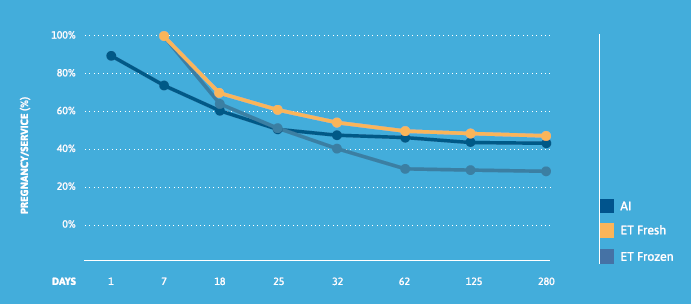Scientific article
The incidence and timing of pregnancy loss derived from timed artificial insemination or timed embryo transfer using fresh or frozen in vitro-produced embryos
Alan D. Crowe, José M. Sánchez, Stephen G. Moore, Michael McDonald, Matthew S. McCabe, P. Federico Rand, Patrick Lanergan & Stephen T. Butler
Publication information
European Buiatrics Congress 2025
Objectives
This study aimed to characterize the incidence and timing of pregnancy loss from the service event timed artificial insemination or timed embryo transfer to parturition.
Materials and Methods
Lactating Holstein-Friesian cows were randomly assigned to receive either timely artificially inseminated (TAI, n = 243) or timely embryo transferred (TET, n = 863) with a fresh or frozen in vitro-produced blastocyst following a protocol consisting off on day 0, cows received a 2-mL intramuscular injection of GnRH analogue (Ovarelin, 100 μg of gonadorelin diacetate tetrahydrate; Ceva Sante Animale, Libourne, France) and a progesterone-releasing intravaginal device (PRID Delta; 1.55 g Progesterone, Ceva). On day 7, a 5-mL intramuscular injection of PGF2α (Enzaprost, 25 mg of dinoprost rometamol; Ceva) was administered, followed by a second 5-mL injection of PGF2α on day 8 and removal of the PRID. On day 9.5 (32 hours fter PRID removal), a second intramuscular injection of GnRH was give, and cows were either inseminated 32h later (TAI) or received a blastocyst 7,5 days after the last GnRH injection. The blastocysts were derived from oocytes collected from the ovaries of elite dairy donors (14 Holstein Friesian and 8 Jersey) and elite beef donors (21 Angus) using transvaginal ovum pick-up. Additionally, oocytes were collected from the ovaries of beef heifers of known pedigree following slaughter at a commercial abattoir (n = 119). Blood samples were collected on day 7 from all cows to determine progesterone concentration, and from subsets of cows on day 18 (n = 524) and day 25 (n = 378) to determine mRNA abundance of interferon-stimulated gene-15 and pregnancy-specific protein B concentration, respectively, for early pregnancy diagnosis. Transrectal ultrasonography was conducted to determine pregnancy status on days 32, 62, and 125 after synchronized ovulation. Parturition dates were recorded for all cows that reached term delivery.
The incidence and timing of pregnancy loss derived from timed artificial insemination or timed embryo transfer using fresh or frozen in vitro-produced embryos 36calving, at the day of calving, and at +7, +14, +28, and +55d after calving. All animals were evaluated for NEFA and BHB levels, while a complete biochemical analysis was performed for 45 animal per group (30 luriparous, and 15 primiparous). Differences in biochemical parameters were assessed with a linear mixed-effects model. A post hoc pairwise comparison was performed using Bonferroni correction. A logistic regression analysis was performed using blood BHB values (healthy, BHB<1.2 mmol/L; hyperketonemia, BHB≥1.2 mmol/L). The model considered the risk factors of treatment, time, parity, and season. A p-value<0.0532 was considered significant, whereas a 0.05≤p-value≤0.10 was considered a trend.
Results
The predicted probability of pregnancy (%) varied at each time point (days 7, 18, 25, 32, 62, 125, parturition) depending on treatment (AI: 77.0, 60.2, 52.3, 48.8, 47.0, 44.6, 44.0; fresh ET: 100.0, 69.5, 60.3, 56.1, 48.4, 46.8, 45.5; frozen ET: 100.0, 61.7, 52.2, 41.6, 32.9, 31.8, 30.2). Regardless of treatment, the largest proportion of pregnancy loss occurred from the service event (AI on day 0 or ET on day 7) to day 18, with minimal loss occurring between day 62 and parturition (AI: 1.8%, fresh ET: 1.9%, frozen ET: 3.5%). Treatment differences in the predicted probability of pregnancy per service event were detected between fresh ET vs. frozen ET on day 32, and both AI and fresh ET vs. frozen ET on days 62, 125, and at parturition. There was a greater probability of pregnancy loss between days 32 and 62 following ET (Fresh: 11.3%, Frozen: 18.0%) than AI (4.0%). The percentage of cows that calved following the transfer of a fresh embryo (45.5%) was similar to AI (44.0%), but lower when a frozen embryo was transferred (30.2%).

Conclusions
In conclusion, AI and fresh ET led to a higher probability of cows becoming pregnant and maintaining the pregnancy to term compared to frozen ET. Cows that were still pregnant on day 62 had a very high likelihood of maintaining the pregnancy to full-term parturition, regardless of treatment. Further work is needed to improve the likelihood of pregnancy establishment and reduce embryonic and fetal mortality following the transfer of a cryopreserved in vitro-produced embryo.
Publication file:





